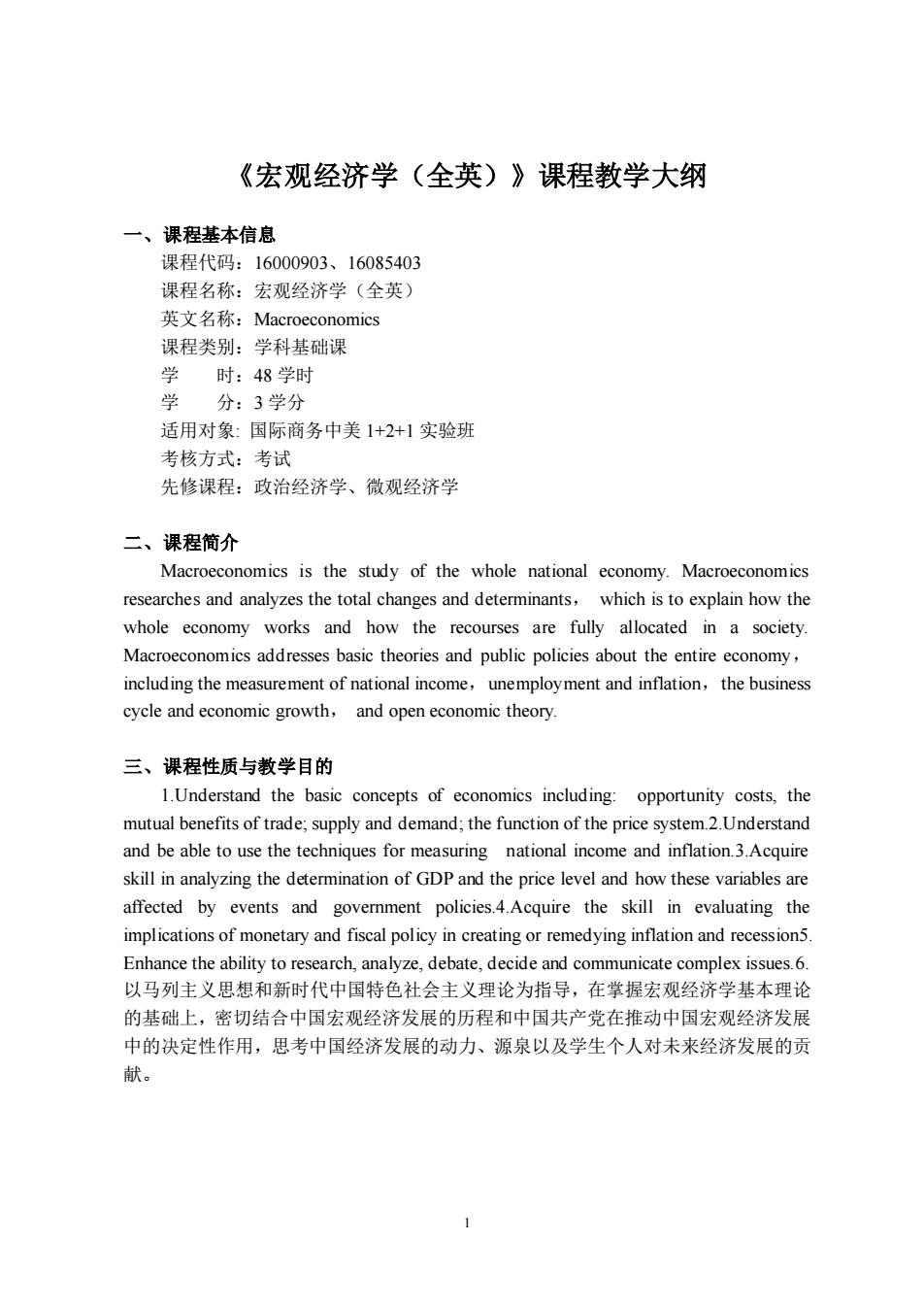
《宏观经济学(全英)》课程教学大纲 一、课程基本信息 课程代码:16000903、16085403 课程名称:宏观经济学(全英) 英文名称:Macroeconomics 课程类别:学科基础课 时:48学时 学 分:3学分 适用对象:国际商务中美1+2+1实验班 老核方式:老试 先修课程:政治经济学、微观经济学 二、课程简介 Macroeconomics is the study of the whole national economy.Macroeconomics researches and analyzes the total changes and determinants,which is to explain how the whole economy works and how the recourses are fully allocated in a society Macroeconomics addresses basic theories and public policies about the entire economy, including the measurement of national income,unemployment and inflation,the business cycle and economic growth,and open economic theory. 三、课程性质与教学目的 1.Understand the basic concepts of economics including:opportunity costs,the mutual benefits of trade;supply and demand:the function of the price system.2.Understand and be able to use the techniques for measuring national income and inflation.3.Acquire skill in analyzing the determination of GDP and the price level and how these variables are affected by events and government policies.4.Acquire the skill in evaluating the implications of monetary and fiscal policy in creating or remedying inflation and recession5. Enhance the ability to research,analyze,debate,decide and communicate complex issues.6. 以马列主义思想和新时代中国特色社会主义理论为指导,在学握宏观经济学基本理论 的基础上,密切结合中国宏观经济发展的历程和中国共产党在推动中国宏观经济发展 中的决定性作用,思考中国经济发展的动力、源泉以及学生个人对未来经济发展的贡 献
1 《宏观经济学(全英)》课程教学大纲 一、课程基本信息 课程代码:16000903、16085403 课程名称:宏观经济学(全英) 英文名称:Macroeconomics 课程类别:学科基础课 学 时:48 学时 学 分:3 学分 适用对象: 国际商务中美 1+2+1 实验班 考核方式:考试 先修课程:政治经济学、微观经济学 二、课程简介 Macroeconomics is the study of the whole national economy. Macroeconomics researches and analyzes the total changes and determinants, which is to explain how the whole economy works and how the recourses are fully allocated in a society. Macroeconomics addresses basic theories and public policies about the entire economy, including the measurement of national income,unemployment and inflation,the business cycle and economic growth, and open economic theory. 三、课程性质与教学目的 1.Understand the basic concepts of economics including: opportunity costs, the mutual benefits of trade; supply and demand; the function of the price system.2.Understand and be able to use the techniques for measuring national income and inflation.3.Acquire skill in analyzing the determination of GDP and the price level and how these variables are affected by events and government policies.4.Acquire the skill in evaluating the implications of monetary and fiscal policy in creating or remedying inflation and recession5. Enhance the ability to research, analyze, debate, decide and communicate complex issues.6. 以马列主义思想和新时代中国特色社会主义理论为指导,在掌握宏观经济学基本理论 的基础上,密切结合中国宏观经济发展的历程和中国共产党在推动中国宏观经济发展 中的决定性作用,思考中国经济发展的动力、源泉以及学生个人对未来经济发展的贡 献
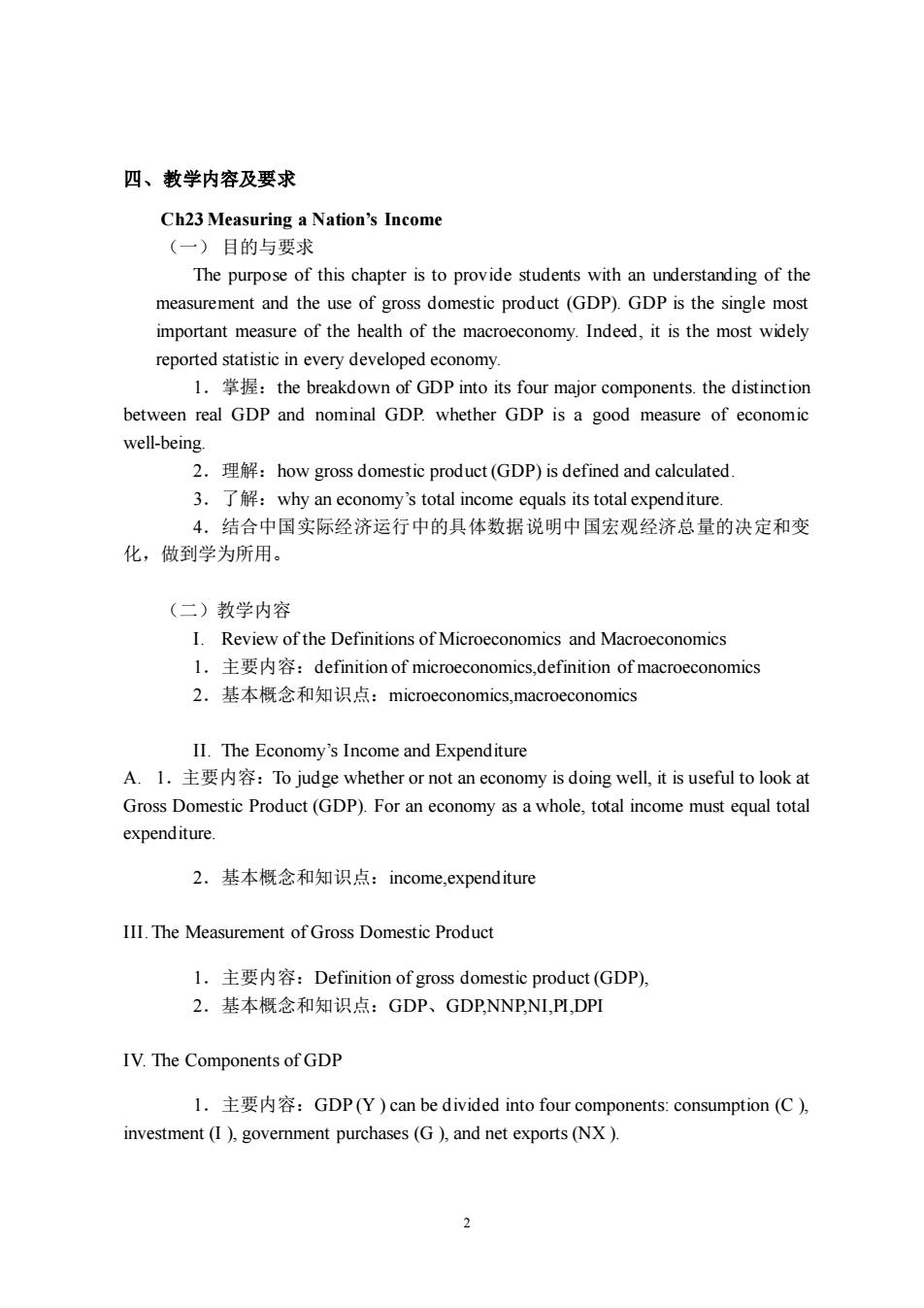
四、教学内容及要求 Ch23 Measuring a Nation's Income (一)目的与要求 The purpose of this chapter is to provide students with an understanding of the measurement and the use of gross domestic product (GDP).GDP is the single most important measure of the health of the macroeconomy.Indeed,it is the most widely reported statistic in every developed economy 1.:the breakdown of GDP into its four major components.the distinction between real GDP and nominal GDP whether GDP is a good measure of economic well-being. 2.s理解:how gross domestic product(GDP)is defined and calculated 3.了f解:why an economy's total income equals its total expenditure. 4.结合中国实际经济运行中的具体数据说明中国宏观经济总量的决定和变 化,做到学为所用。 (一)教学内容 I.Review of the Definitions of Microeconomics and Macroeconomics l.主要内容:definition of microeconomics.definition of macroeconomics 2.基本概念和知识点:microeconomics,macroeconomics II.The Economy's Income and Expenditure A.l.主要内容:To judge whether or not an economy is doing wel,it is useful to look at Gross Domestic Product(GDP).For an economy as a whole,total income must equal total expenditure. 2.基本概念和知识点:income,.expenditure III.The Measurement of Gross Domestic Product l.主要内容:Definition of gross domestic product(GDP), 2.基本概念和知识点:GDP、GDP,NNP,NL,PI,DPI IV.The Components of GDP .主要内容:GDP(Y)can be divided into four components:consumption(C), investment (I),goverment purchases(G),and net exports(NX). 2
2 四、教学内容及要求 Ch23 Measuring a Nation’s Income (一) 目的与要求 The purpose of this chapter is to provide students with an understanding of the measurement and the use of gross domestic product (GDP). GDP is the single most important measure of the health of the macroeconomy. Indeed, it is the most widely reported statistic in every developed economy. 1.掌握:the breakdown of GDP into its four major components. the distinction between real GDP and nominal GDP. whether GDP is a good measure of economic well-being. 2.理解:how gross domestic product (GDP) is defined and calculated. 3.了解:why an economy’s total income equals its total expenditure. 4.结合中国实际经济运行中的具体数据说明中国宏观经济总量的决定和变 化,做到学为所用。 (二)教学内容 I. Review of the Definitions of Microeconomics and Macroeconomics 1.主要内容:definition of microeconomics,definition of macroeconomics 2.基本概念和知识点:microeconomics,macroeconomics II. The Economy’s Income and Expenditure A. 1.主要内容:To judge whether or not an economy is doing well, it is useful to look at Gross Domestic Product (GDP). For an economy as a whole, total income must equal total expenditure. 2.基本概念和知识点:income,expenditure III.The Measurement of Gross Domestic Product 1.主要内容:Definition of gross domestic product (GDP), 2.基本概念和知识点:GDP、GDP,NNP,NI,PI,DPI IV. The Components of GDP 1.主要内容:GDP (Y ) can be divided into four components: consumption (C ), investment (I ), government purchases (G ), and net exports (NX )
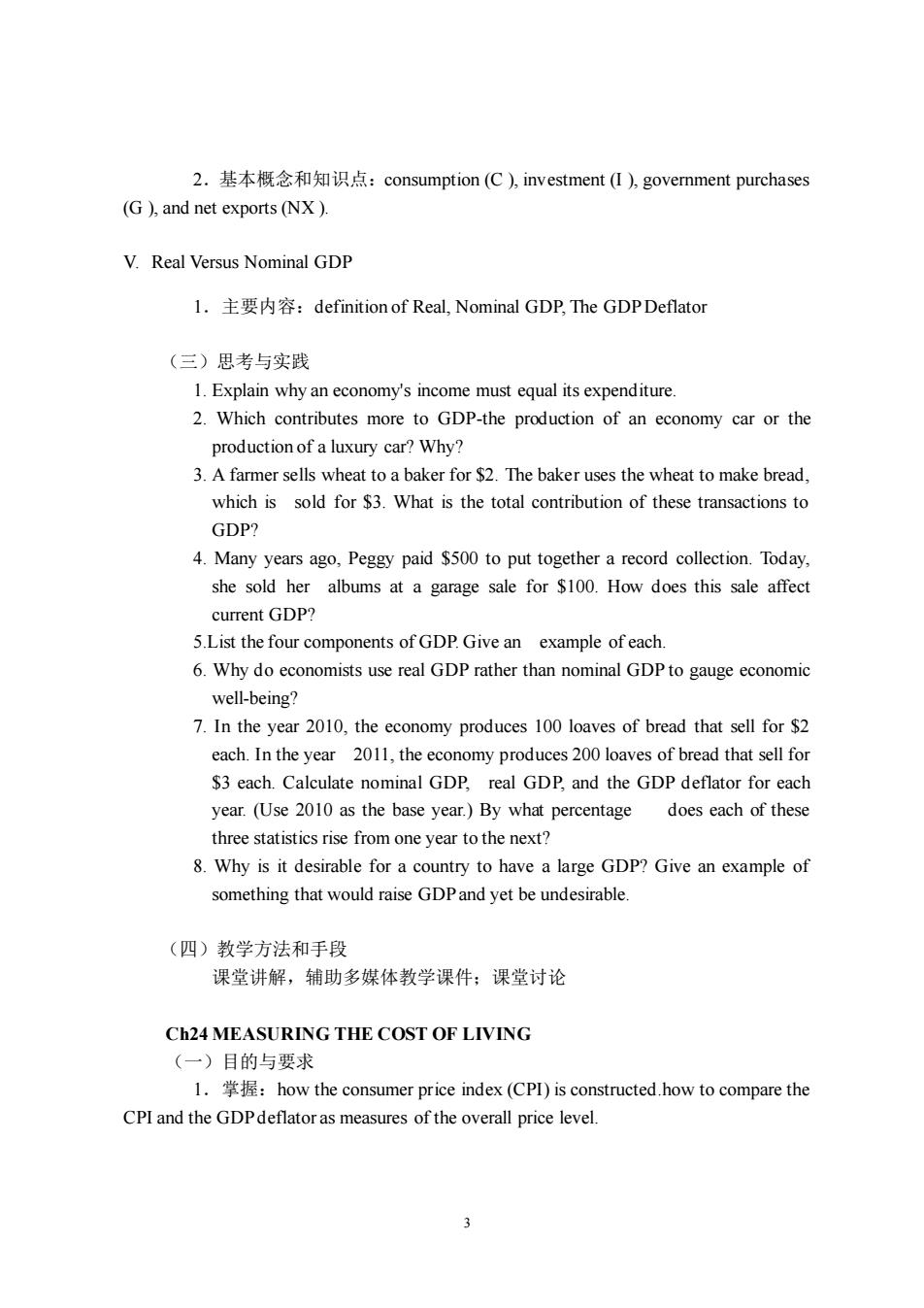
2.基本概念和知识点:consumption(C),investment(I),government purchases (G),and net exports(NX). V.Real Versus Nominal GDP .主要内容:definition of Real,Nominal GDP,The GDP Deflator (三)思考与实践 1.Explain why an economy's income must equal its expenditure. 2.Which contributes more to GDP-the production of an economy car or the production of a luxury car?Why? 3.A farmer sells wheat to a baker for $2.The baker uses the wheat to make bread, which is sold for $3.What is the total contribution of these transactions to GDP? 4.Many years ago.Peggy paid $500 to put together a record collection.Today. she sold her albums at a garage sale for $100.How does this sale affect current GDP? 5.List the four components of GDP.Give an example of each. 6.Why do economists use real GDP rather than nominal GDPto gauge economic well-being? 7.In the year 2010,the economy produces 100 loaves of bread that sell for $2 each.In the year 2011,the economy produces 200 loaves of bread that sell for $3 each.Calculate nominal GDP.real GDP,and the GDP deflator for each year.(Use 2010 as the base year.)By what percentage does each of these three statistics rise from one year to the next? 8.Why is it desirable for a country to have a large GDP?Give an example of something that would raise GDPand yet be undesirable. (四)教学方法和手段 课堂讲解,辅助多媒体教学课件:课堂讨论 Ch24 MEASURING THE COST OF LIVING (一)目的与要求 1.:how the consumer price index(CPI)is constructed.how to compare the CPI and the GDPdeflator as measures of the overall price level 3
3 2.基本概念和知识点:consumption (C ), investment (I ), government purchases (G ), and net exports (NX ). V. Real Versus Nominal GDP 1.主要内容:definition of Real, Nominal GDP, The GDP Deflator (三)思考与实践 1. Explain why an economy's income must equal its expenditure. 2. Which contributes more to GDP-the production of an economy car or the production of a luxury car? Why? 3. A farmer sells wheat to a baker for $2. The baker uses the wheat to make bread, which is sold for $3. What is the total contribution of these transactions to GDP? 4. Many years ago, Peggy paid $500 to put together a record collection. Today, she sold her albums at a garage sale for $100. How does this sale affect current GDP? 5.List the four components of GDP. Give an example of each. 6. Why do economists use real GDP rather than nominal GDP to gauge economic well-being? 7. In the year 2010, the economy produces 100 loaves of bread that sell for $2 each. In the year 2011, the economy produces 200 loaves of bread that sell for $3 each. Calculate nominal GDP, real GDP, and the GDP deflator for each year. (Use 2010 as the base year.) By what percentage does each of these three statistics rise from one year to the next? 8. Why is it desirable for a country to have a large GDP? Give an example of something that would raise GDP and yet be undesirable. (四)教学方法和手段 课堂讲解,辅助多媒体教学课件;课堂讨论 Ch24 MEASURING THE COST OF LIVING (一)目的与要求 1.掌握:how the consumer price index (CPI) is constructed.how to compare the CPI and the GDP deflator as measures of the overall price level
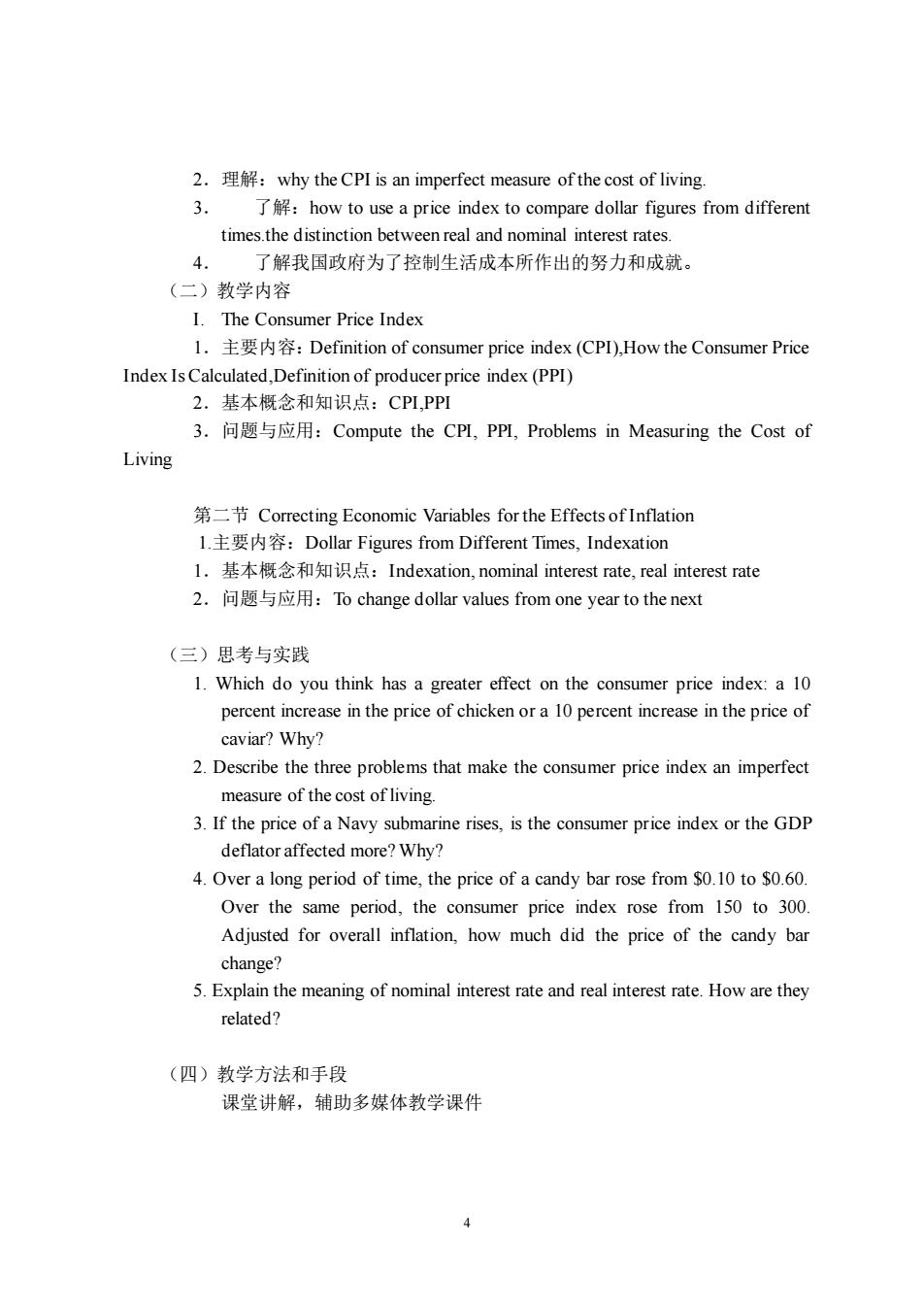
2.s理解:why the CPI is an imperfect measure of the cost of living. 了f解:how to use a price index to compare dollar figures from different times the distinction between real and nominal interest rates. 4. 了解我国政府为了控制生活成本所作出的努力和成就。 (二)教学内容 I.The Consumer Price Index L.主要内容:Definition of consumer price index(CPI),How the Consumer Price Index Is Calculated Definition of producer price index (PPI) 2.基本概念和知识点:CPI,PPI 3.问题与应用:Compute the CPI,PpL,Problems in Measuring the Cost of Living s第二节Correcting Economic Variables for the Effects of Inflatior L.主要内容:Dollar Figures from Different Times,.Indexation L.基本概念和知识点:Indexation,nominal interest rate,real interest rate 2.问题与应用:To change dollar values from one year to the next (三)用老与实践 1.Which do you think has a greater effect on the consumer price index:a 10 percent increase in the price of chicken or a 10 percent increase in the price of caviar?Why? 2.Describe the three problems that make the consumer price index an imperfect measure of the cost of living. 3.If the price of a Navy submarine rises,is the consumer price index or the GDP deflator affected more?Why? 4.Over a long period of time,the price of a candy bar rose from $0.10 to $0.60. Over the same period,the consumer price index rose from 150 to 300. Adjusted for overall inflation,how much did the price of the candy bar change? 5.Explain the meaning of nominal interest rate and real interest rate.How are they related? (四)教学方法和手段 课堂讲解,辅助多媒体教学课件 4
4 2.理解:why the CPI is an imperfect measure of the cost of living. 3. 了解:how to use a price index to compare dollar figures from different times.the distinction between real and nominal interest rates. 4. 了解我国政府为了控制生活成本所作出的努力和成就。 (二)教学内容 I. The Consumer Price Index 1.主要内容:Definition of consumer price index (CPI),How the Consumer Price Index Is Calculated,Definition of producer price index (PPI) 2.基本概念和知识点:CPI,PPI 3.问题与应用:Compute the CPI, PPI, Problems in Measuring the Cost of Living 第二节 Correcting Economic Variables for the Effects of Inflation 1.主要内容:Dollar Figures from Different Times, Indexation 1.基本概念和知识点:Indexation, nominal interest rate, real interest rate 2.问题与应用:To change dollar values from one year to the next (三)思考与实践 1. Which do you think has a greater effect on the consumer price index: a 10 percent increase in the price of chicken or a 10 percent increase in the price of caviar? Why? 2. Describe the three problems that make the consumer price index an imperfect measure of the cost of living. 3. If the price of a Navy submarine rises, is the consumer price index or the GDP deflator affected more? Why? 4. Over a long period of time, the price of a candy bar rose from $0.10 to $0.60. Over the same period, the consumer price index rose from 150 to 300. Adjusted for overall inflation, how much did the price of the candy bar change? 5. Explain the meaning of nominal interest rate and real interest rate. How are they related? (四)教学方法和手段 课堂讲解,辅助多媒体教学课件
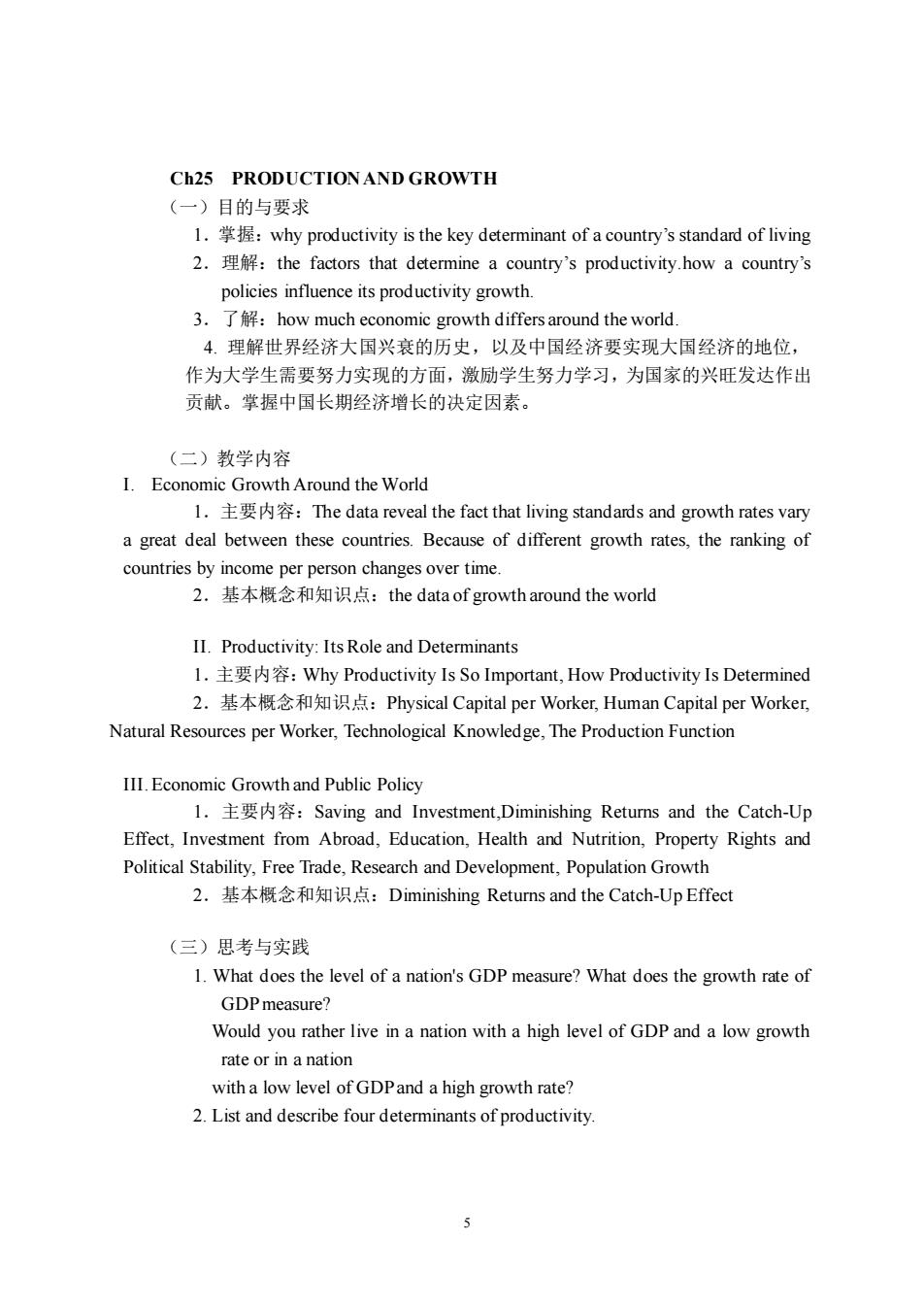
Ch25 PRODUCTIONAND GROWTH (一)目的与要求 1.:why productivity is the key determinant of a country's standard of living 2.:the factors that determine a country's productivity.how a country's policies influence its productivity growth. 3.了解:how much economic growth differs around the world. 4.理解世界经济大国兴衰的历史,以及中国经济要实现大国经济的地位, 作为大学生需要努力实现的方面,激励学生努力学习,为国家的兴旺发达作出 贡献。掌握中国长期经济增长的决定因素。 (一)教学内容 I.Economic Growth Around the World l.主要内容:The data reveal the fact that living standards and growth rates vary a great deal between these countries.Because of different growth rates,the ranking of countries by income per person changes over time. 2.基本概念和知识点:the data of growth around the world II Productivity:Its Role and Determinants l.主要内容:Why Productivity Is So Important,.How Productivity Is Determined 2.基本概念和知识点:Physical Capital per Worker,.Human Capital per Worker,. Natural Resources per Worker,Technological Knowledge,The Production Function III.Economic Growth and Public Policy l.主要内容:Saving and Investment,Diminishing Returns and the Catch-Up Effect,Investment from Abroad,Education,Health and Nutrition,Property Rights and Political Stability,Free Trade,Research and Development,Population Growth 2.基本概念和知识点:Diminishing Retums and the Catch-Up Effec (三)思考与实我 1.What does the level of a nation's GDP measure?What does the growth rate of GDPmeasure? Would you rather live in a nation with a high level of GDP and a low growth rate or in a nation with a low level of GDPand a high growth rate? 2.List and describe four determinants of productivity. 5
5 Ch25 PRODUCTION AND GROWTH (一)目的与要求 1.掌握:why productivity is the key determinant of a country’s standard of living 2.理解:the factors that determine a country’s productivity.how a country’s policies influence its productivity growth. 3.了解:how much economic growth differs around the world. 4. 理解世界经济大国兴衰的历史,以及中国经济要实现大国经济的地位, 作为大学生需要努力实现的方面,激励学生努力学习,为国家的兴旺发达作出 贡献。掌握中国长期经济增长的决定因素。 (二)教学内容 I. Economic Growth Around the World 1.主要内容:The data reveal the fact that living standards and growth rates vary a great deal between these countries. Because of different growth rates, the ranking of countries by income per person changes over time. 2.基本概念和知识点:the data of growth around the world II. Productivity: Its Role and Determinants 1.主要内容:Why Productivity Is So Important, How Productivity Is Determined 2.基本概念和知识点:Physical Capital per Worker, Human Capital per Worker, Natural Resources per Worker, Technological Knowledge, The Production Function III.Economic Growth and Public Policy 1.主要内容:Saving and Investment,Diminishing Returns and the Catch-Up Effect, Investment from Abroad, Education, Health and Nutrition, Property Rights and Political Stability, Free Trade, Research and Development, Population Growth 2.基本概念和知识点:Diminishing Returns and the Catch-Up Effect (三)思考与实践 1. What does the level of a nation's GDP measure? What does the growth rate of GDPmeasure? Would you rather live in a nation with a high level of GDP and a low growth rate or in a nation with a low level of GDP and a high growth rate? 2. List and describe four determinants of productivity
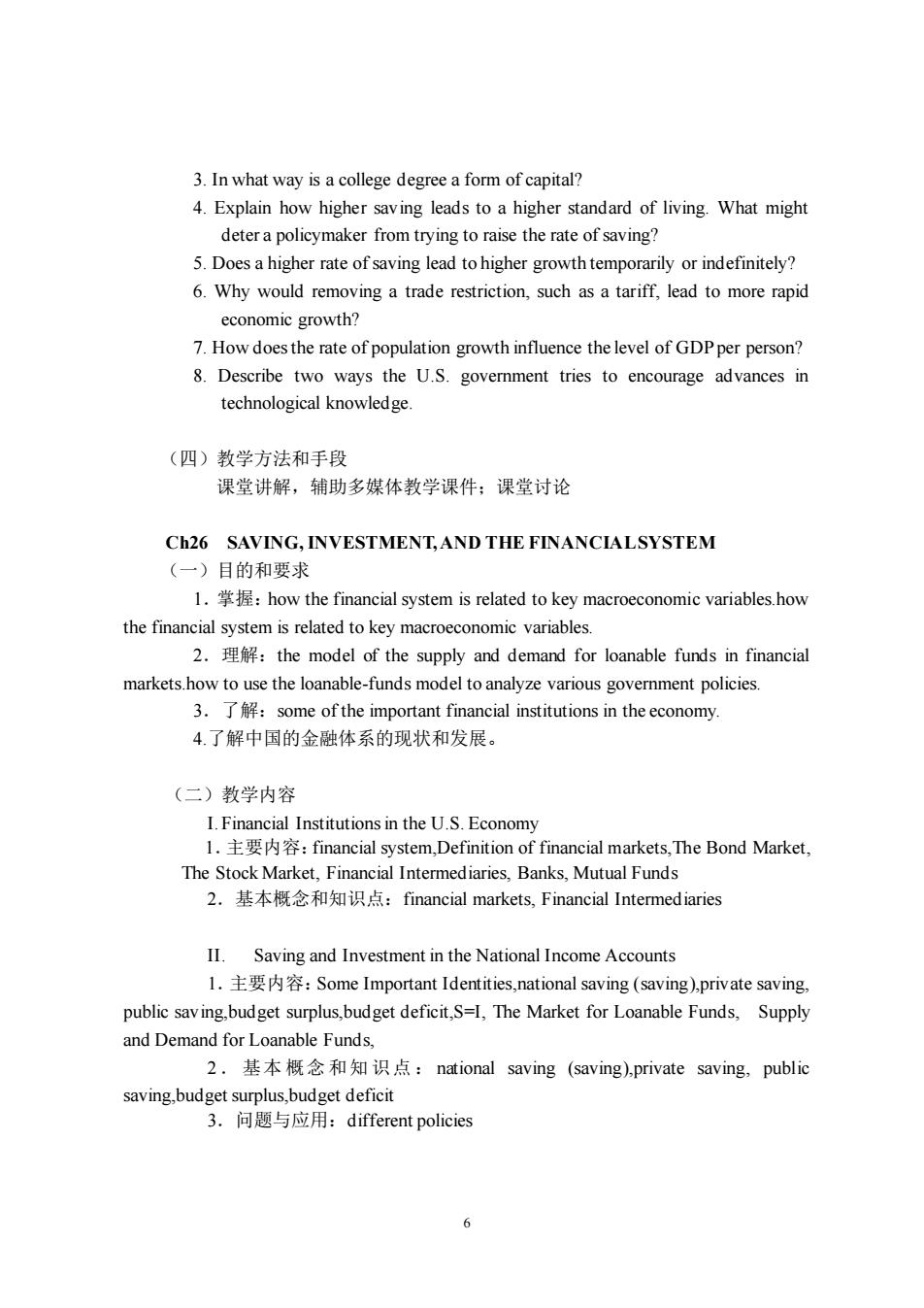
3.In what way is a college degree a form of capital? 4.Explain how higher saving leads to a higher standard of living.What might deter a policymaker from trying to raise the rate of saving? 5.Does a higher rate of saving lead to higher growth temporarily or indefinitely? 6.Why would removing a trade restriction,such as a tariff,lead to more rapid economic growth? 7.How doesthe rate of population growth influence the level of GDPper person? 8.Describe two ways the U.S.government tries to encourage advances in technological knowledge (四)教学方法和手段 课堂讲解,辅助多媒体教学课件;课堂讨论 Ch26 SAVING.INVESTMENT AND THE FINANCIALSYSTEM (一)目的和要求 1.:how the financial system is related to key macroeconomic variables.how the financial system is related to key macroeconomic variables 2.:the model of the supply and demand for loanable funds in financial markets how to use the loanable-funds model to analyze various government policies 3.J:some of the important financial institutions in the economy. 4.了解中国的金融体系的现状和发展。 (二)教学内容 1.主要内容:fm f fin nan cial markets,The Bond Market The Stock Market,Financial Intermediaries,Banks,Mutual Funds 2.基本概念和知识点:financial markets,Financial Intermediaries I1.Saving and Investment in the National Income Accounts 1.主要内容:Some Important Identities,national saving(saving),private saving, public saving.budget surplus,budget deficit,S=I,The Market for Loanable Funds,Supply and Demand for Loanable Funds, 2.基本概念和知识点:national saving(saving),private saving,public saving.budget surplus,budget deficit 3.问题与应用:different policies 6
6 3. In what way is a college degree a form of capital? 4. Explain how higher saving leads to a higher standard of living. What might deter a policymaker from trying to raise the rate of saving? 5. Does a higher rate of saving lead to higher growth temporarily or indefinitely? 6. Why would removing a trade restriction, such as a tariff, lead to more rapid economic growth? 7. How does the rate of population growth influence the level of GDP per person? 8. Describe two ways the U.S. government tries to encourage advances in technological knowledge. (四)教学方法和手段 课堂讲解,辅助多媒体教学课件;课堂讨论 Ch26 SAVING, INVESTMENT, AND THE FINANCIAL SYSTEM (一)目的和要求 1.掌握:how the financial system is related to key macroeconomic variables.how the financial system is related to key macroeconomic variables. 2.理解:the model of the supply and demand for loanable funds in financial markets.how to use the loanable-funds model to analyze various government policies. 3.了解:some of the important financial institutions in the economy. 4.了解中国的金融体系的现状和发展。 (二)教学内容 I.Financial Institutions in the U.S. Economy 1.主要内容:financial system,Definition of financial markets,The Bond Market, The Stock Market, Financial Intermediaries, Banks, Mutual Funds 2.基本概念和知识点:financial markets, Financial Intermediaries II. Saving and Investment in the National Income Accounts 1.主要内容:Some Important Identities,national saving (saving),private saving, public saving,budget surplus,budget deficit,S=I, The Market for Loanable Funds, Supply and Demand for Loanable Funds, 2 . 基本 概念 和知 识点 : national saving (saving),private saving, public saving,budget surplus,budget deficit 3.问题与应用:different policies
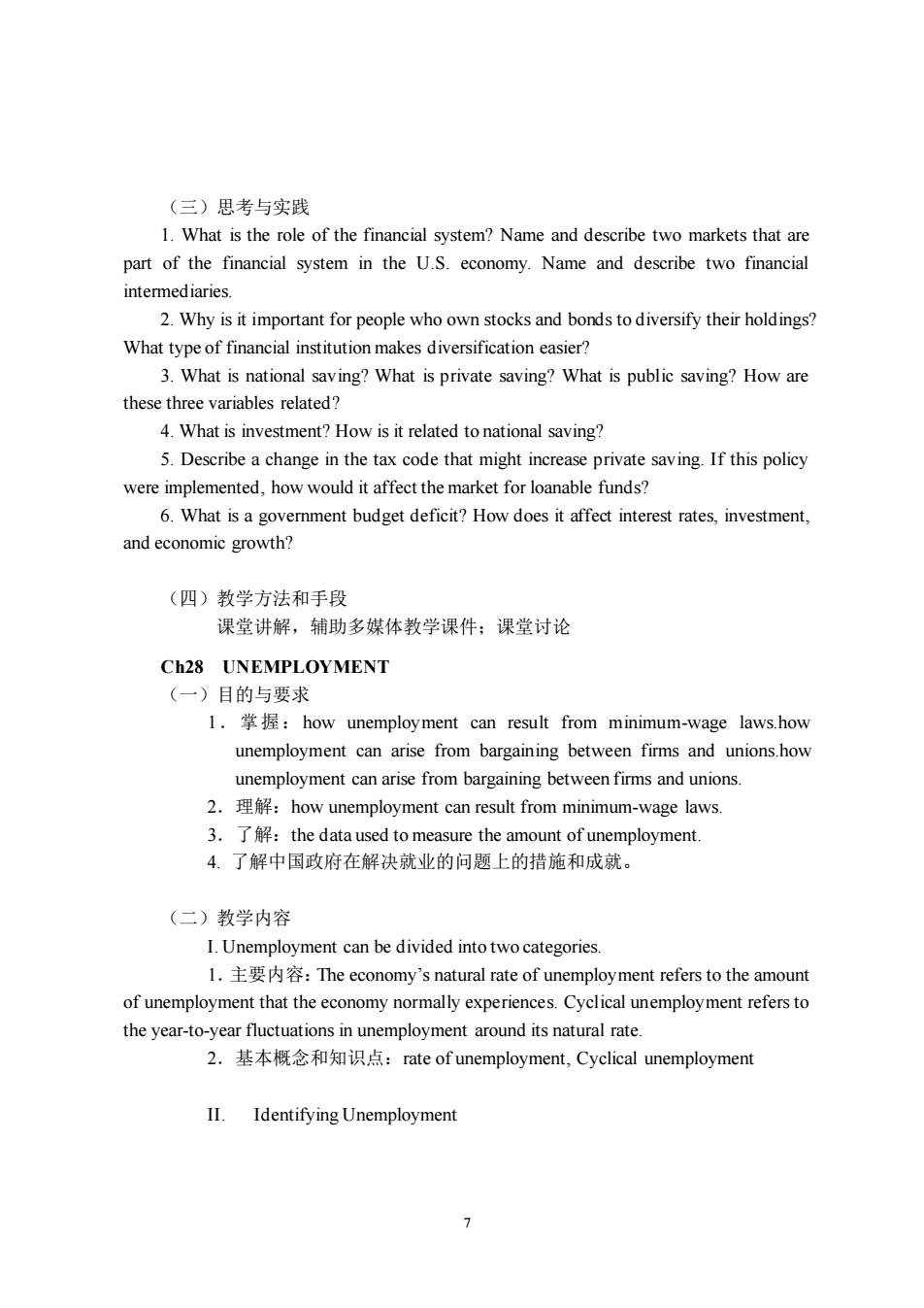
(三)思考与实践 1.What is the role of the financial system?Name and describe two markets that are part of the financial system in the U.S.economy.Name and describe two financial intermediaries 2.Why is it important for people who own stocks and bonds todiversify their holdings? What type of financial institution makes diversification easier? 3.What is national saving?What is private saving?What is public saving?How are these three variables related? 4.What is investment?How is it related to national saving? 5.Describe a change in the tax code that might increase private saving.If this policy were implemented.how would it affect the market for loanable funds? 6.What is a govemment budget deficit?How does it affect interest rates,investment, and economic growth? (四)教学方法和手段 课堂讲解,辅助多媒体教学课件;课堂讨论 Ch28 UNEMPLOYMENT (一)目的与要求 1.掌握:how unemployment can result from minimum-wage laws.how unemployment can arise from bargaining between firms and unions how unemployment can arise from bargaining between firms and unions. 2.a理解:how unemployment can result from minimum-wage laws. 3.了解:the data used to measure the amount of unemployment. 4.了解中国政府在解决就业的问题上的措施和成就 (二)教学内容 I.Unemployment can be divided into twocategories l.主要内容:The economy's natural rate of unemployment refers to the amount of unemployment that the economy normally experiences.Cyclical unemployment refers to the year-to-year fluctuations in unemployment around its natural rate. 2.基本概念和知识点:rate of unemployment,Cyclical unemployment II.Identifying Unemployment 7
7 (三)思考与实践 1. What is the role of the financial system? Name and describe two markets that are part of the financial system in the U.S. economy. Name and describe two financial intermediaries. 2. Why is it important for people who own stocks and bonds to diversify their holdings? What type of financial institution makes diversification easier? 3. What is national saving? What is private saving? What is public saving? How are these three variables related? 4. What is investment? How is it related to national saving? 5. Describe a change in the tax code that might increase private saving. If this policy were implemented, how would it affect the market for loanable funds? 6. What is a government budget deficit? How does it affect interest rates, investment, and economic growth? (四)教学方法和手段 课堂讲解,辅助多媒体教学课件;课堂讨论 Ch28 UNEMPLOYMENT (一)目的与要求 1.掌握:how unemployment can result from minimum-wage laws.how unemployment can arise from bargaining between firms and unions.how unemployment can arise from bargaining between firms and unions. 2.理解:how unemployment can result from minimum-wage laws. 3.了解:the data used to measure the amount of unemployment. 4. 了解中国政府在解决就业的问题上的措施和成就。 (二)教学内容 I. Unemployment can be divided into two categories. 1.主要内容:The economy’s natural rate of unemployment refers to the amount of unemployment that the economy normally experiences. Cyclical unemployment refers to the year-to-year fluctuations in unemployment around its natural rate. 2.基本概念和知识点:rate of unemployment, Cyclical unemployment II. Identifying Unemployment
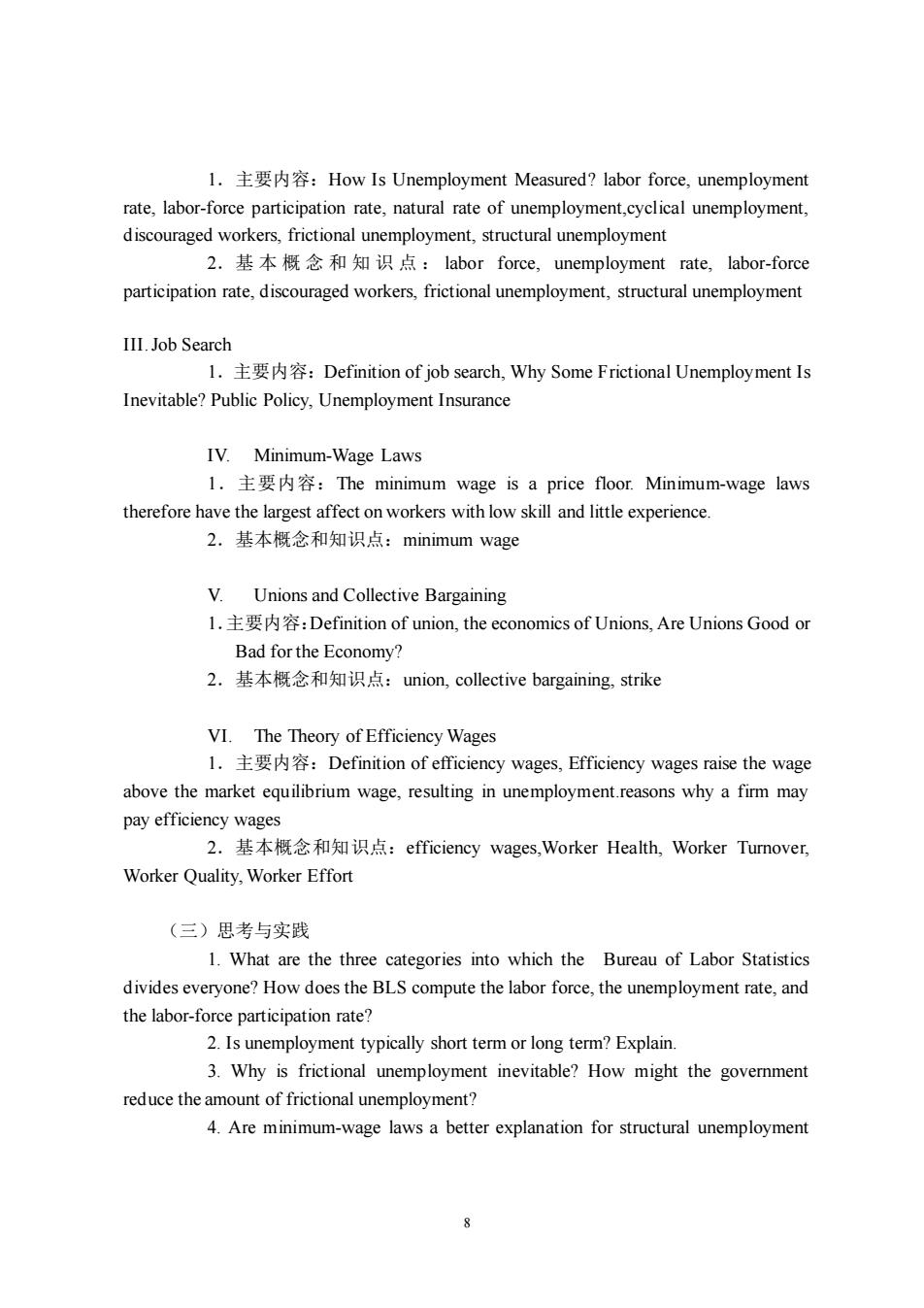
l.主要内容:How Is Unemployment Measured?labor force,unemployment rate,labor-force participation rate,natural rate of unemployment,cyclical unemployment, discouraged workers,frictional unemployment,structural unemployment 2.基本概念和知识点:labor force,unemployment rate,labor-force participation rate,discouraged workers,frictional unemployment,structural unemployment III.Job Search L.主要内容:Definition of job search,Why Some Frictional Unemployment Is Inevitable?Public Policy,Unemployment Insurance IV.Minimum-Wage Laws 1.主要内容:The minimum wage is a price floor..Minimum-wage laws therefore have the largest affect on workers with low skill and little experience. 2.基本概念和知识点:minimum wage Unions and Collective Bargaining l.主要内容:Definition of union,.the economics of Unions,Are Unions Good or Bad for the Economy? 2.基本概念和知识点:union,.collective bargaining,strike VI.The Theory of Efficiency Wages l.主要内容:Definition of efficiency wages,.Efficiency wages raise the wage above the market equilibrium wage,resulting in unemployment.reasons why a firm may pay efficiency wages 2.基本概念和知识点:efficiency wages,.Worker Health,.Worker Tumover, Worker Quality,Worker Effort (三)思考与实践 1.What are the three categories into which the Bureau of Labor Statistics divides everyone?How does the BLS compute the labor force,the unemployment rate,and the labor-force participation rate? 2.Is unemployment typically short term or long term?Explain. 3.Why is frictional unemployment inevitable?How might the government reduce the amount of frictional unemployment? 4.Are minimum-wage laws a better explanation for structural unemployment
8 1.主要内容:How Is Unemployment Measured? labor force, unemployment rate, labor-force participation rate, natural rate of unemployment,cyclical unemployment, discouraged workers, frictional unemployment, structural unemployment 2.基本概念和知识点: labor force, unemployment rate, labor-force participation rate, discouraged workers, frictional unemployment, structural unemployment III.Job Search 1.主要内容:Definition of job search, Why Some Frictional Unemployment Is Inevitable? Public Policy, Unemployment Insurance IV. Minimum-Wage Laws 1.主要内容:The minimum wage is a price floor. Minimum-wage laws therefore have the largest affect on workers with low skill and little experience. 2.基本概念和知识点:minimum wage V. Unions and Collective Bargaining 1.主要内容:Definition of union, the economics of Unions, Are Unions Good or Bad for the Economy? 2.基本概念和知识点:union, collective bargaining, strike VI. The Theory of Efficiency Wages 1.主要内容:Definition of efficiency wages, Efficiency wages raise the wage above the market equilibrium wage, resulting in unemployment.reasons why a firm may pay efficiency wages 2.基本概念和知识点:efficiency wages,Worker Health, Worker Turnover, Worker Quality, Worker Effort (三)思考与实践 1. What are the three categories into which the Bureau of Labor Statistics divides everyone? How does the BLS compute the labor force, the unemployment rate, and the labor-force participation rate? 2. Is unemployment typically short term or long term? Explain. 3. Why is frictional unemployment inevitable? How might the government reduce the amount of frictional unemployment? 4. Are minimum-wage laws a better explanation for structural unemployment
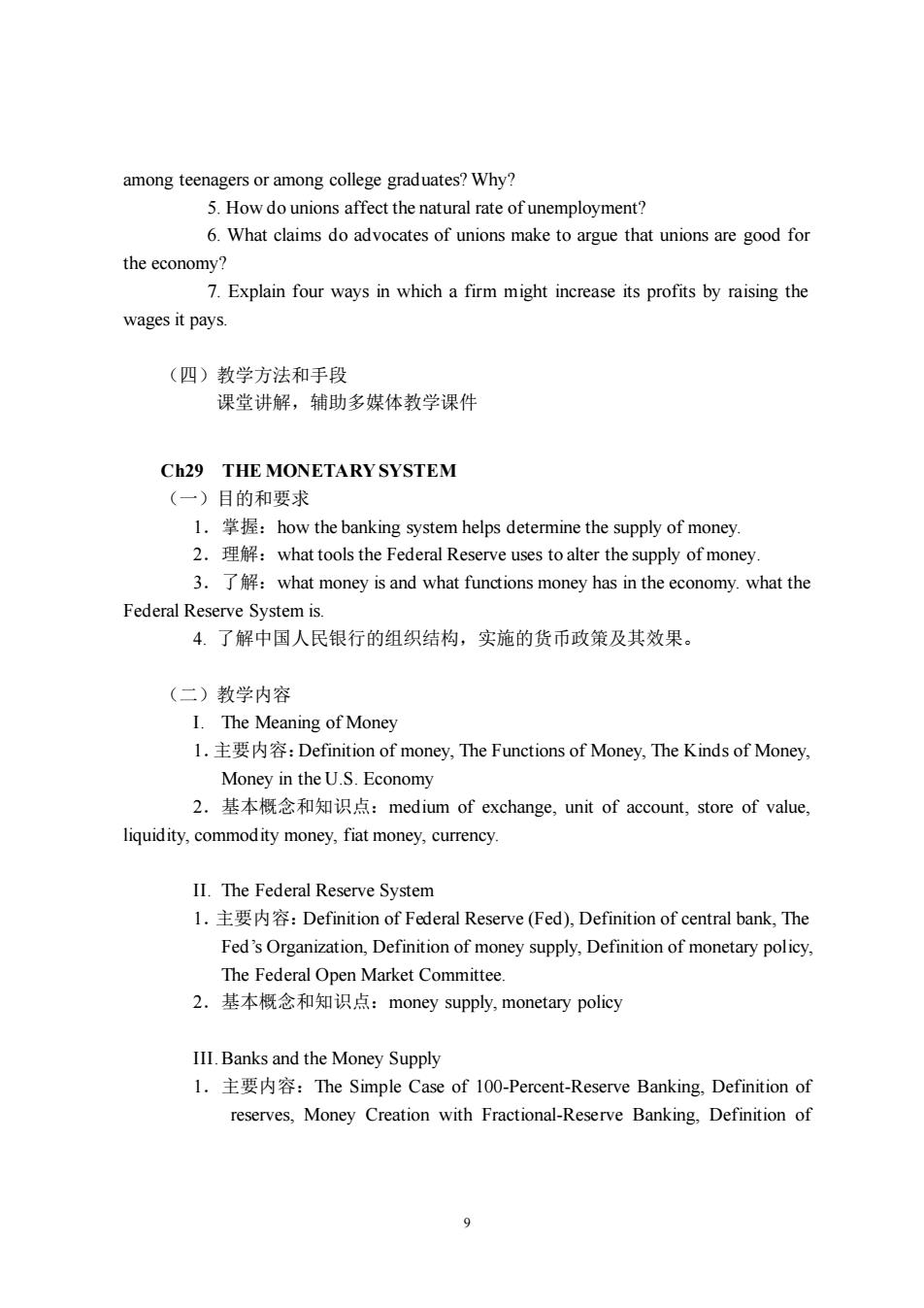
among teenagers or among college graduates?Why? 5.How do unions affect the natural rate of unemployment? 6.What claims do advocates of unions make to argue that unions are good for the economy? 7.Explain four ways in which a firm might increase its profits by raising the wages it pays. (四)教学方法和手段 课堂讲解,辅助多媒体教学课件 Ch29 THE MONETARY SYSTEM (一)目的和要求 .掌握:how the banking system helps determine the supply of money.. 2.:what tools the Federal Reserve uses to alter the supply of money. 3.:what money is and what functions money has in the economy.what the Federal Reserve System is. 4.了解中国人民银行的组织结构,实施的货币政策及其效果 (二)教学内容 I.The Meaning of Money L.主a要内容:Definition of money,.The Functions of Money,The Kinds of Money, Money in the U.S.Economy 2.基本概念和知识点:medium of exchange,unit of account,store of value, liquidity,commodity money,fiat money,currency. II.The Federal Reserve System L.主要内容:Definition of Federal Reserve(Fed),Definition of central bank,.The Fed's Organization,Definition of money supply,Definition of monetary policy, The Federal Open Market Committee. 2.基本概念和知识点:money supply,monetary policy III.Banks and the Money Supply l.主要内容:The Simple Case of 1000-Percent-Reserve Banking,Definition of reserves,Money Creation with Fractional-Reserve Banking.Definition of 9
9 among teenagers or among college graduates? Why? 5. How do unions affect the natural rate of unemployment? 6. What claims do advocates of unions make to argue that unions are good for the economy? 7. Explain four ways in which a firm might increase its profits by raising the wages it pays. (四)教学方法和手段 课堂讲解,辅助多媒体教学课件 Ch29 THE MONETARY SYSTEM (一)目的和要求 1.掌握:how the banking system helps determine the supply of money. 2.理解:what tools the Federal Reserve uses to alter the supply of money. 3.了解:what money is and what functions money has in the economy. what the Federal Reserve System is. 4. 了解中国人民银行的组织结构,实施的货币政策及其效果。 (二)教学内容 I. The Meaning of Money 1.主要内容:Definition of money, The Functions of Money, The Kinds of Money, Money in the U.S. Economy 2.基本概念和知识点:medium of exchange, unit of account, store of value, liquidity, commodity money, fiat money, currency. II. The Federal Reserve System 1.主要内容:Definition of Federal Reserve (Fed), Definition of central bank, The Fed’s Organization, Definition of money supply, Definition of monetary policy, The Federal Open Market Committee. 2.基本概念和知识点:money supply, monetary policy III.Banks and the Money Supply 1.主要内容:The Simple Case of 100-Percent-Reserve Banking, Definition of reserves, Money Creation with Fractional-Reserve Banking, Definition of

fractional-reserve banking,Definition of reserve ratio,The Money Multiplier The Fed's Tools of Monetary Control,Definition of open market operations, Definition of reserve requirements,Definition ofdiscount rate. 2.基本概念和知识点:reserves,.The Money Multiplier.Tools of Monetary Control The Federal Funds Rate 3.问题与应用:Problems in Controlling the Money Supply (三)思考与实践 1.What distinguishes money from other assets in the economy? 2.What is commodity money?What is fiat money?Which kind do we use? 3.What are demand deposits and why should they be included in the stock of money? 4.Who is responsible for setting monetary policy in the United States?How is this group chosen? 5.If the Fed wants to increase the money supply with open-market operations, what does it do? 6.Why don't banks hold 100 percent reserves?How is the amount of reserves banks hold related to the amount of money the banking system creates? 7.Bank A has a leverage ratio of 10,while Bank B has a leverage ratio of 20 Similar losses on bank loans at the two banks cause the value of their assets to fall by 7 percent.Which bank shows a larger change in bank capital?Does either bank remain solvent?Explain. 8.What is the discount rate?What happens to the money supply when the Fed raises the discount rate? 9.What are reserve requirements?What happens to the money supply when the Fed raises reserve requirements? 10.Why can't the Fed control the money supply perfectly? (四)教学方法和手段 课堂讲解,辅助多媒体教学课件:课堂讨论 Ch30 MONEY GROWTHAND INFLATION (一)目的与要求 1.:the meaning of the classical dichotomy and monetary neutrality.why some countries print so much money that they experience hyperinflation.how 10
10 fractional-reserve banking, Definition of reserve ratio,The Money Multiplier. The Fed’s Tools of Monetary Control,Definition of open market operations, Definition of reserve requirements, Definition of discount rate. 2.基本概念和知识点:reserves, The Money Multiplier, Tools of Monetary Control, The Federal Funds Rate 3.问题与应用:Problems in Controlling the Money Supply (三)思考与实践 1. What distinguishes money from other assets in the economy? 2. What is commodity money? What is fiat money? Which kind do we use? 3. What are demand deposits and why should they be included in the stock of money? 4. Who is responsible for setting monetary policy in the United States? How is this group chosen? 5. If the Fed wants to increase the money supply with open-market operations, what does it do? 6. Why don't banks hold 100 percent reserves? How is the amount of reserves banks hold related to the amount of money the banking system creates? 7. Bank A has a leverage ratio of 10, while Bank B has a leverage ratio of 20. Similar losses on bank loans at the two banks cause the value of their assets to fall by 7 percent. Which bank shows a larger change in bank capital? Does either bank remain solvent? Explain. 8. What is the discount rate? What happens to the money supply when the Fed raises the discount rate? 9. What are reserve requirements? What happens to the money supply when the Fed raises reserve requirements? 10. Why can't the Fed control the money supply perfectly? (四)教学方法和手段 课堂讲解,辅助多媒体教学课件;课堂讨论 Ch30 MONEY GROWTH AND INFLATION (一)目的与要求 1.掌握:the meaning of the classical dichotomy and monetary neutrality. why some countries print so much money that they experience hyperinflation. how